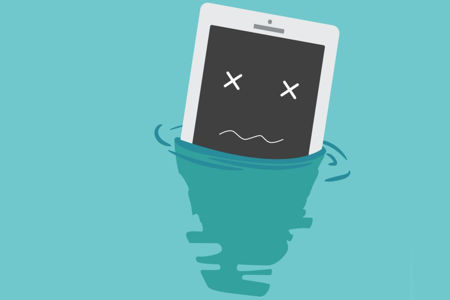Water can be the bane of electronics. The heat generated by most electronic components can cause condensation moisture that most systems allow for and deal with through insulation. However, when high amounts of water are involved, such as that caused when a device is dropped in a pool of water, the need to try and salvage your components and the electronics they are part of becomes work.
What does water or other liquids do to electronics? ElectronicsForU notes:
“When liquids come in contact with circuits, currents can be inadvertently diverted (shorted) to other system components, where there can be two possible routes: burnout or grounding. When a burnout happens, a higher-current circuit (such as that from a power-handling circuit) is allowed to go through a more delicate circuit that was not designed for high currents, resulting in circuit components over-heating and melting”.
In the case of shorts that ground a circuit, there is less chance for harming the components as grounding components can handle higher current loads. This result is much better than burning out and being destroyed.
RyTech suggests some specific rules for dealing with wet electronics:
-
Don’t turn on electronics that are suspected of exposure to water or high levels of water vapor. Leave them off and unplug the unit.
-
Don’t try to dry electronic components in a microwave oven or conventional oven.
-
Don’t open up wet electronic items yourself to let them air-dry. Refer that job to a qualified electronics technician.
So if you can dry the system fully there is a good chance the electronics will work again. But, the type of liquid can impact the result. Water or other liquids can contain salts and other particles that have a corrosive effect even after drying as they are not removed. The particles can cause current to go where it is not supposed to and cause major damage.
There are a few things to also be aware of:
-
Do not delay - according to reports, the optimal time for addressing this is 48 hours. Longer than that and the damage may not be recoverable.
-
Rice is not an effective way to dry electronics. Studies show you are better off leaving the device in the open air.
If you want to get into more detailed information and find out about more components and water damage, Grainger has very thorough information.
But there are numerous components that can be salvaged from various electronics.
-
Motherboards - connectors, sockets, heatsinks, capacitors, and inductors
-
Computer Power Supplies - transformers, regulators, ICs, Inductors, capacitors and heatsinks
-
Amplifiers and Sound Systems - capacitors, switches, knobs, potentiometers, jacks, LEDs, chips, big heatsinks and cooling fan
-
Voltage Regulators - relays, indicator LEDs, switches, a volt meter and those comparator ic's.
-
Automotive - fuses, relays, halogen bulbs, horn, and all other things that you can salvage from an old car.
Hopefully, this will give you some insights into salvaging components. There are many other products that have reusable components.
contact us:
 EN
EN
 English
English
 Chinese
Chinese
 Italiano
Italiano
 Portuguese
Portuguese
 Deutschland
Deutschland
 French
French
 Russian
Russian
 Japanese
Japanese
 Turkish
Turkish
 Korean
Korean
 Spanish
Spanish
 my account & orders
my account & orders

